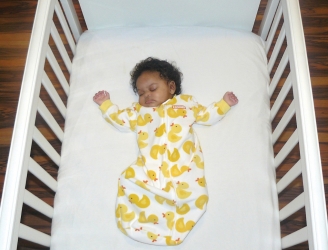
Safe Sleep: Remember Your ABCs
The lives of many babies are cut short by being put to sleep in an unsafe sleep environment. In the U.S. more than 3,500 infants die every year while sleeping. Often this is due to sudden infant death syndrome (SIDS) or from accidental suffocation or strangulation.
Every year, there are more than 100 infant deaths that result from, or are associated with an unsafe sleep environment. These deaths are preventable by following a few key recommendations from the American Academy of Pediatrics or AAP. The primary message for parents and others who care for infants is to "Remember the ABCs of Safe Sleep." There are three critical measures to follow when it's time for an infant to sleep.
"A" is for Alone: Always let the baby sleep alone, never in a bed with another person where the baby could be smothered. "B" is for on the baby's Back: An infant should be placed to sleep on his or her back, not on his or her side or stomach. "C" is for Crib: Always put your child to sleep in a crib with only a firm mattress and tight-fitting sheet.
In addition to the ABCs, you can help reduce the risk of sleep-related death by following these tips:
- Place your baby on a firm sleep surface. Use a safety-approved crib mattress covered with a fitted sheet. Never place a baby to sleep on a pillow, quilt, sheepskin or other soft surface.
- Keep loose objects, soft toys and bedding out of the baby's sleep area.
- Do not use pillows and blankets in a baby's sleeping area. Keep all items away from the baby’s face.
- Keep your baby’s crib, bassinet or portable crib in the same room where you sleep for the first 6 months to one year.
- Keep your baby from overheating during the night. A baby should be dressed lightly for sleep. Set the room temperature in a range that is comfortable for a lightly clothed adult.
- Do not use crib bumpers. These do not reduce injuries and can cause suffocation.
- Never place your baby to sleep on a sofa, arm chair or couch.
- It’s ok to swaddle your baby, but make sure they are always on their backs. When your baby looks like he or she is starting to roll over, you should stop swaddling.
- Try giving your baby a pacifier at bedtime or naptime, it helps reduce the risk of SIDS.
- Don’t smoke during pregnancy, and don’t expose your baby to secondhand smoke after birth.
- Only bring your baby into your bed to feed or comfort. Place baby back in crib when you’re ready to sleep.
- Breastfeed for at least the first six months of life. Babies who breastfeed have a lower risk of SIDS.
- The AAP recommends that parents put their baby to sleep in a crib or bassinet in the parents' bedroom for the first six months.
Be sure to discuss these safety tips with all your baby’s caregivers, including babysitters, childcare providers and grandparents.
When buying sleep aid products;
· There are a lot of products that claim to help reduce the risk of SIDS, use caution when purchasing these products. According to the AAP, wedges, positioners, special mattresses and specialized sleep surfaces have not been shown to reduce the risk of SIDS.
· Parents should not rely on home heart or breathing monitor to reduce SIDS. Talk with your pediatrician before using these.
· Use caution when purchasing bedside or in-bed sleepers. The AAP can’t recommend to use or not use these products since there have been no studies to look at their effect on SIDS or if they increase the risk of injury and death from suffocation.
You can learn more about consumer product recalls here.
Watch this video to learn more about the ABCs of safe sleep from the Tennessee Department of Health: